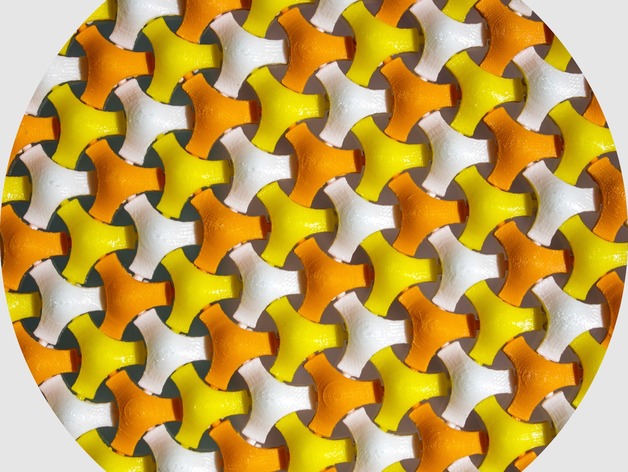
TriSphere Flexable Mesh
thingiverse
Like FlexMesh, TriSphere is a geometric pattern I developed about a year ago to explore the boundaries of today's low-cost 3D printing technologies. I believe the origins of this pattern are from the celtic tradition. I have every intention of improving the joinery in this design, both to ease assembly and to improve the flexibility of the resulting fabric. But after a year of other more pressing priorities, I'm releasing this version for designers to play with. As I've tried to show in the accompanying photos, the TriSphere fabric results from the spacial interaction of 3 separate mats. Each mat is constructed using two basic shapes -- Mains and Subs. Mains are the 3-legged pieces that are most prominently visible in the assembled design. Subs, which are mostly hidden underneath the Mains, are used to join one leg of each of the adjoining Mains of a mat. For the sake of clarity, the colors I've chosen for the Mains of each mat in the design shown here are all the same color. So all the yellow pieces you see are connected to each other via Subs, as are all the white and orange pieces. But there is no explicit connection in the resulting fabric between the white, yellow or orange mats. Like a traditional thread-based fabric, each mat is held in place by the combined weave of the constituent pieces of all three mats. Though each mat of the fabric shown here consists of Mains of the same color, even more interesting patterns can be created/discovered from the weaving of mats constructed of Mains of two or more colors. One of the screenshots that I've enclosed shows just such a pattern using 9 different colored Mains. I'd love to see the magic other users conjure up by creatively experimenting with the mixing and distributing of different colored Mains to create interesting fabric patterns. It's my sense that there's a tremendous amount of creative potential in doing so. Instructions You can print the parts of this design using PLA, PETG, or ABS. Back when I was immersed in this design, ABS was my material of choice for experimenting. So the fabric shown here was printed in ABS at 220 with 2 shells and 20% infill without raft or supports. Always searching for ways to keep costs down, I've found that both Mains and Subs come out pretty well even when printed using fairly low-quality filament.
With this file you will be able to print TriSphere Flexable Mesh with your 3D printer. Click on the button and save the file on your computer to work, edit or customize your design. You can also find more 3D designs for printers on TriSphere Flexable Mesh.
